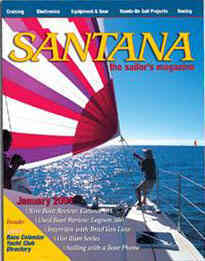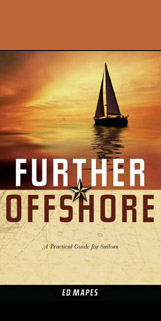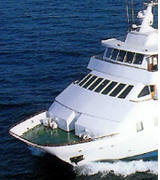|
|

ďYou know how to use your life preserver. But what
about your boatís?
Knowing how to use your para-anchor can save your life!Ē
By Zack Smith
appearing in the 2001 issue of Santana.
Your parachute sea anchor can do more than steady your boat in heavy
seas. It also saves lives! But, thereís a catch. It canít do you or your
boat any good unless you know how to use it properly. That means you
have to practice.
Practice Gives You A Clear Advantage.
Itís estimated that 90 percent of para-anchor owners donít practice
using their underwater drag device. And thatís incredibly dangerous!
Training teaches us just how exhaustion
can take over in crisis situations. And thatís a condition you surely
want to avoid, because mistakes are most likely to occur when youíre
exhausted! What I find amazing is how many people opt to abandon their
vessel without deploying their para-anchor. When asked, ďwhy?Ē The
answer is always the same, ďI didnít know if it would work,Ē or ďI
didnít think it would work.Ē
Itís not surprising that people think this way. Concerns in the
reliability of drag devices are primarily based on conflicting
information published in some sailing books and other publications.
Currently, youíll find two schools of thought regarding heavy weather
strategies. According to popular belief, you can actively run like hell
and hope you donít get broached, pooped, or pitch poled. Or, on the side
of passive tactics, you can deploy a para-anchor that will ďparkĒ you
out in the middle of the ocean, where you can pray your boat doesnít
break apart from the strain or from the boat swinging out of control.
An example of both tactics can be found in books like "Rescue in the
Pacific" by Tony Farrington. This story exemplifies the disastrous
outcome that most often occurs when drogues wrap around props and the
people aboard the vessels attempt to build makeshift drag devices.
Thatís very scary stuff. You can avoid such disaster by practicing with
the proper equipment. Training with your gear takes the mystery out of
using your drag device, so that it will work when you need it most.
The Importance of Using a Drag Device
Most sailboats by themselves survive incredibly huge storms. Itís the
people being tossed around inside the vessel who make the decisions that
ultimately end in their demise or rescue. Take Fastnet 79, Queens
Birthday Storm, and the Sydney-Hobart race, for example. With a few
exceptions, those boats kept floating after they were abandoned. What if
these same sailors couldíve stabilized their wildly bucking boats--would
they still have abandoned their boat? The secret is in stabilizing the
boat.
The para-anchor is designed to steady a vessel in moderate to heavy
weather situations by pulling the bow toward oncoming seas. A position
far safer than lying beam to. For a few poor souls stuck offshore in a
nightmare storm it becomes a necessity to calm the violent motions
caused by a rolling boat. Luckily, most sailors deploy a para-anchor
system because of exhaustion or seasickness. Not because of a life or
death situation.
Trilibrium Factors Keep You Steady in the Wind
A boatís stability is achievable through three elements of balance.
These ďTrilibrium FactorsĒ are:
1) Sail trim;
2) Rudder positioning; and
3) Rode length.
My sail plan typically includes a second or third reef on the main and a
storm jib up forward before I deploy my para-anchor. If the vessel is
bare poled, I keep her head into the wind while motoring astern. After
positioning the vessel into a hove to or head on position I deploy a
boat fender connected to a 50-foot floating line from the windward bow.
I donít drop the para-anchor into the water until I see the trip line
floating away from the boat.
If you follow this scenario, you can then snub the anchor rode right
away. You will immediately feel the para-anchor tug vigorously. Donít be
concerned. Thatís what itís supposed to do as it begins to open. Rudder
position should be slightly to windward, unless your vessel is falling
off the wind. For stubborn vessels that lay beam to, rudder position
should be hard over to windward.
Pay Attention to Slacking Anchor Rode
Once youíve conquered the rudder, pay out small portions of anchor rode
at a time to avoid slack in the system that may allow your vessel to
drift beam to the seas. In force 8 or 9 conditions, I deploy from 50
feet to 150 feet of nylon rode and secure the line off a cleat. Then I
wait to see how the boat behaves. If the bow of the boat starts jerking
or feels like itís being pulled through the waves, I deploy more rode.
If my vessel feels like it is heading beam to the seas--even after
adjusting sail and rudder--some rode needs to be retrieved, because
thereís too much slack in the system.
Darkness, ocean spray, and squalls make it a rule of thumb to feel your
way through deploying the proper amount of rode. If you want to prepare
for a worse case scenario storm, you should consider carrying 10 feet of
anchor rode per foot of boat.
Multihull sailors typically use fixed bridles with their para-anchor.
However, that doesnít allow them to adjust their rode length. If you use
a fixed bridle, consider using 12 feet of chain or an equivalent to 16
pounds near the para-anchor to reduce anchor rode slack. For monohull
vessels, itís a good idea to carry a minimum 6 feet of chain for heavy
storm conditions. Just attach it near the para-anchor to reduce rode
slack and to hold the parachute below dangerous breaking waves.
Anchor rode chafe can be a problem for some vessels. The saw like motion
of the rode moving over a fairlead, roller guard, or boat edge can
create enough energy to cut fibers. Chafe is preventable by using 24 to
36 inches of high-pressure hose or two layers of firehose. Simply pay
the rode through the protective cover until it reaches the eye splice at
the end of the rode. Secure the chafe protection to the boat so that you
can pay out rode at your discretion.
At the Stormís End
Once the storm has died down and youíre ready to move on, itís time to
pull in the anchor rode slack. Do this as you head for the trip line.
The retrieval float at the end of your trip line serves as a marker for
you to motor toward. Boat hook in hand, grab hold of the retrieval float
on the windward bow. Pull the trip line aboard and the collapsed
parachute canopy will follow. Packing it away is easy. Modern para-anchors
are designed to stow in minutes.
Parachute anchors are a significant tool for combating heavy seas. When
used properly, a para-anchor lets you get much-needed rest in any sea
condition and stabilizes the boat during layovers, breakdowns, and other
emergency situations. The rigging instructions Iíve provided have been
effectively used since 1947. If you follow my advice, you should have
little or no problem keeping your vessel balanced in heavy winds and
waves. But keep in mind that larger, heavier vessels tend to ride to
para-anchors quite easily while other lighter sailboats take more time
to balance. Using bridles, staysails, and riding sails usually balance
out the most stubborn of vessels. For an opportunity to learn more about
parachute anchors visit
Zack's FAQ's.

Click
here to learn more about
Santana Magazine. |
|
















